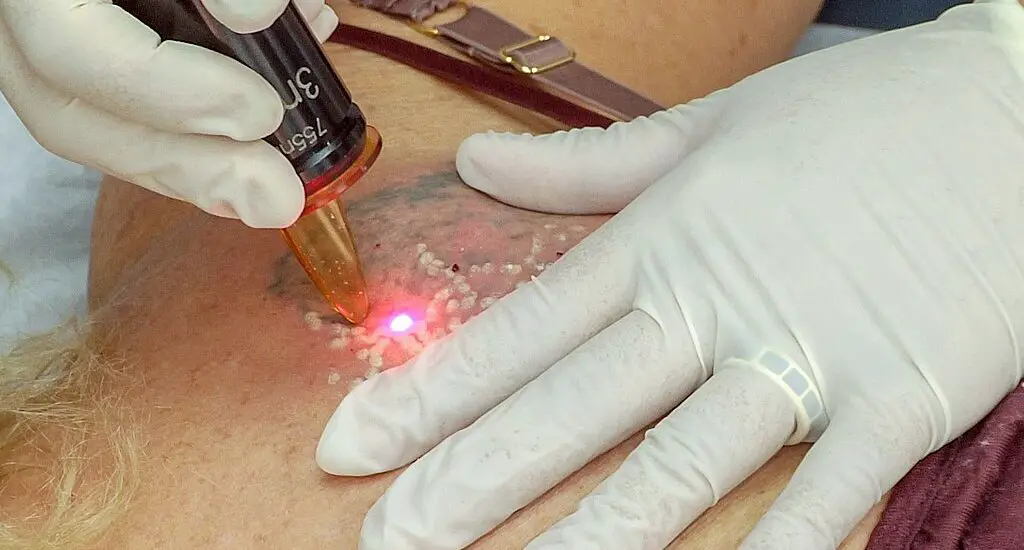Can you still see a tattoo after laser removal? This detailed article aims to address this question comprehensively, providing essential information for a clear understanding.

Can You Still See a Tattoo After Laser Removal?
After undergoing laser tattoo removal, the extent to which the tattoo remains visible can vary. While modern laser technology is advanced, the complete removal of a tattoo often remains challenging.
The residual visibility of the tattoo can manifest in various ways. It might manifest as faint outlines of the original design, slight discoloration, or shadowing in the treated area. In some cases, it manifests as small fragments of ink that resist complete eradication. (Source)
This residual visibility is influenced by several factors:
Laser Technology: Technologies like Q-switched and picosecond lasers are specifically designed to target tattoo ink. They work by emitting high-energy light absorbed by the ink. Then they break it down into smaller particles that the body can then remove. The specific wavelength of light used is crucial as it determines how effectively the laser can target different ink colors.
Ink Quality: Higher quality inks that are more saturated can be harder to break down.
Color of Ink: Darker colors like black and blue absorb laser light more effectively, making them easier to remove. Lighter colors, such as yellows, greens, and fluorescent hues, may not absorb laser energy as efficiently, leading to incomplete removal.
Depth of Ink: Ink injected deeper into the skin can be more challenging to remove compared to superficially placed ink.
Age of Tattoo: Older tattoos may fade more with treatment than newer ones due to ink degradation over time.
Individual Skin Characteristics: Factors such as skin tone, texture, and the individual’s immune response play a significant role in how effectively the tattoo ink is removed and how the skin heals post-treatment.
Technician’s Expertise: The experience and skill of the laser technician are crucial in achieving the best results. Proper technique and laser settings can significantly impact the effectiveness of the treatment.
Even with the most advanced laser treatments, there is always a possibility that some part of the tattoo will remain visible. This is a crucial consideration for anyone thinking about laser tattoo removal.
Check out these other articles…
What Happens to the Skin After Laser Tattoo Removal?
How to Care for Your Tattoo After Laser Removal: Easy Guide
How Long Does Skin Take to Heal After Laser Tattoo Removal?
Skin Healing After Laser Tattoo Removal: Comprehensive Guide
Hole in Skin After Laser Tattoo Removal: Comprehensive Guide
Post-Treatment Care and Healing
After laser tattoo removal, the treated area requires proper care to heal effectively and reduce the risk of complications. The typical healing process involves:
Immediate Skin Reaction: Common immediate reactions include redness, swelling, blistering, and sometimes minor bleeding. These are normal signs of the skin’s healing process.
Aftercare Instructions: Following the specific aftercare instructions provided by the clinic is vital. This may include applying prescribed ointments and keeping the area clean and dry. Furthermore, you’ll be required to avoid certain activities such as swimming and protect the skin from sun exposure.
Overall Health: Maintaining good overall health, including proper hydration, nutrition, and avoiding smoking, can enhance the body’s ability to heal and remove fragmented ink particles.
Adhering to these care instructions is essential for minimizing complications and achieving the best possible outcomes from the treatment.
The Importance of Professional Consultation
Consulting with a qualified dermatologist or a certified laser removal specialist before undergoing laser tattoo removal is crucial. During the consultation, the professional will:
Evaluate the Tattoo: Assess the tattoo’s size, color, depth, and location to determine the most effective removal strategy.
Discuss Expectations: Provide a realistic outlook on the possible results of the treatment, including the potential for incomplete removal and the number of sessions required.
Explain Risks: Inform about any potential risks or side effects associated with the laser treatment.
Tailored Treatment Plan: Develop a customized treatment plan that considers the specific characteristics of your tattoo and skin type.
Aftercare Guidance: Offer advice on how to care for the treated area post-procedure to ensure optimal healing and results.
A professional consultation is an invaluable step in the laser tattoo removal process, ensuring that you are fully informed and prepared for the treatment and its aftermath.


